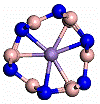Department of Physics and Astronomy: Publications and Other Research

Stephen Ducharme Publications
Document Type
Article
Date of this Version
1-2016
Citation
Journal of Physical Chemistry Letters 7:3 (January 2016), pp. 435−440.
doi: 10.1021/acs.jpclett.5b02472
Abstract
The synthesis of 2D H-bonded cocrystals from the room-temperature ferroelectric organics croconic acid (CA) and 3-hydroxyphenalenone (3-HPLN) is demonstrated through self-assembly on a substrate under ultrahigh vacuum. 2D cocrystal polymorphs of varied stoichiometry were identified with scanning tunneling microscopy, and one of the observed structural building blocks consists of two CA and two 3-HPLN molecules. Computational analysis with density functional theory confirmed that the experimental (CA)2(3-HPLN)2 tetramers are lower in energy than single-component structures due to the ability of the tetramers to pack efficiently in two dimensions, the promotion of favorable electrostatic interactions between tetramers, and the optimal number of intermolecular hydrogen bonds. The structures investigated, especially the experimentally found tetrameric building blocks, are not polar. However, it is demonstrated computationally that cocrystallization can, in principle, result in heterogeneous structures with dipole moments that exceed those of homogeneous structures and that 2D structures with select stoichiometries could favor metastable polar structures.


Comments
Copyright © 2016 American Chemical Society. Used by permission.